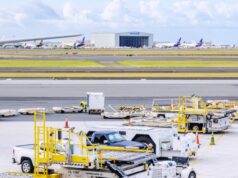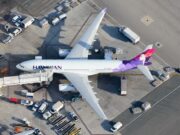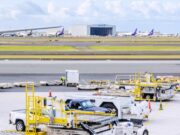It is time to reconsider how we teach flight. For years the accident statistics have consistently shown results of too many fatalities in General Aviation accidents. There have been numbers of articles and suggestions about the risks involved in all flight. However, I have yet to see definition of the problems.
Loss of Control is noted as a leading cause of accidents. The aircraft is designed and built to essentially fly by itself, so what is loss of control? What causes loss of control? How do you prevent loss of control?
Control is steering of the machine to direct it in a desired manner for completion of flight. Steering is done by the pilot through use of flight controls. Loss of control then is caused by the pilot. To prevent loss of control, it requires the pilot be trained how to allow the aircraft to fly as designed.
This is an attempt to define what is missing and suggest how to improve your training.
In addition to some unintended consequences of regulation, there are errors and missing information in all aviation texts.
Thrust Lifting
The major missing information is consideration of lift occurring at the engine attachment. In the tractor aircraft operation, any angle of attack that directs the thrust slightly above the direction of motion creates a small lift force. This lifting adds to the total lift acting on the aircraft and is used for most level and climb maneuvering rather than elevator control.
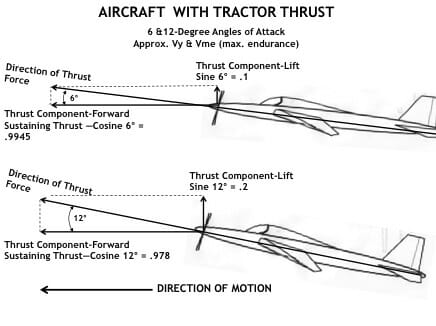
Engine lifting causes climb angle when thrust is increased above level flight sustaining thrust. In a banked attitude, the maneuver becomes a horizontal climb with coordinated thrust causing added total lift for constant vertical lift and level turning flight.
Level turn maneuvering with added thrust can be done to a bank angle at which thrust has been increased to maximum. Any further bank increase for level turn requires aft elevator with accepting slowed flight.
Turn Maneuvering
All texts say for turn, the attitude is banked and aft elevator applied to maintain level. The emphasis needs to be made that elevator input always causes change of angle-of-attack and a related indicated-airspeed change. That is all it ever does! Any resulting altitude control requires coordinating thrust to the new indicated-airspeed. Most level turns can be made with coordinated thrust.

Stalls
Stalling the aircraft is caused by holding aft elevator input. No text emphasizes that it is the Pilot that causes stall! That is the only way it can happen. If the control wheel is released, the aircraft will immediately resume the current elevator trimmed setting and continue to fly. We spend lots of time teaching how to stall and recover but little to no emphasis on the only way the stall can occur in the first place.
Loss of Control
Inadvertent IMC is a common loss of control situation. The immediate onset of vertigo is extremely difficult to resist without prior training. Some early model Cessna 150 and 172’s had recovery as a published emergency procedure.
Turn loose of the control wheel and concentrating on the turn and bank instrument, with rudder only control establish a standard rate turn for one minute then level the wings and fly out of the conditions. Adding thrust will cause climb if needed to help reestablish visual.
“Hands-off Flight Control”!
The aircraft was designed to fly and in fact will fly all by itself if released with applied power. The Pilot only controls. It is possible to fly a complete flight from start of taxi to takeoff, climb, cruise, descent, and approach without touching the control wheel. Just maneuver with thrust for altitude and direction with rudder. Setting the elevator trim for a desired indicated-airspeed the aircraft will maintain that indicated-airspeed throughout.
An excellent article published in the 2014 Mar/Apr FAA Safety-Brief discusses how manual control is applied and the physiological implications of doing so. All Pilots should be able to safely control an aircraft without the use of elevator control.
Emergency Landings
No matter the cause requiring an emergency landing, it is the flight control to the touchdown area that leads to an accident…and the accident does not occur until at or after touchdown and only then if there is damage or injury.
According to 2001 FAA statistics, seventy-five percent of off field emergency landings touchdown mid-field or beyond on the chosen site. Fifty percent of the fatalities from these landings come from overrunning the site.
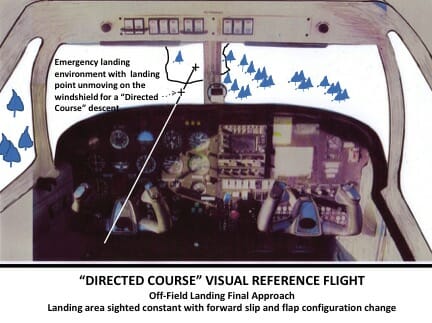
Image provided by Robert Reser
An unintended consequence of regulation calling for extended landing approaches eliminated the common practice of idle-thrust landings. The result is for over forty years there has been no requirement for Private Pilot proficiency in this type landing…which just happens to be the equivalent procedure for engine-out landings. Additionally, the extended approaches have resulted in much wasted training time in the traffic pattern. Proficiency in idle-power landings makes extended approaches seem simple.
When landing in emergency conditions, at touchdown the pilot will immediately become aware when no longer in control. At that time the pilot and passengers must be protecting themselves as best as possible… especially protecting the head to be conscious when stopped.
Inadvertent IMC
Another emergency situation which relies on hands-off minimum elevator control is inadvertent flight into IMC or dark night loss of visual orientation. In this case, it is imperative the pilot understand to release the control wheel and using the turn and bank or attitude indicator for reference, steer with rudder into a standard rate turn (approx. 20-25 degree bank) for one minute, then reverse to zero bank and fly out of the situation.
If continuing into the situation, keep a zero bank indication on the turn and bank with rudder steering and crosscheck of heading with the compass. Adding power to increase altitude, climbing will possibly regain visual references.
These situations normally cause feelings of vertigo and must be minimized by sitting upright with little if any movement of the head. Believe the instruments, not how you feel.
Low Air-Density Operation
The idea that an aircraft does not fly well in “thin air” has been promoted forever. It just happens the aircraft doesn’t know the air is thin. It just increases velocity in the current conditions, continuing to operate normally at the same indicated-airspeeds as in dense air…so what is wrong? It’s available thrust. That is the only change. Engines just don’t provide the same power in low density air. Operation is at higher velocities relative the ground for landing and takeoff so require longer runways. For takeoff there will be minimum total thrust for acceleration and when becoming airborne most becomes sustaining thrust with minimum excess for maneuvering.

A typical light aircraft approximately 2,000 lbs. with fixed propeller requires about 200 lbs. of thrust to sustain itself around an indicated-airspeed of Vy. This aircraft at sea level can produce approximately 600 lbs. of thrust, so when becoming airborne, will have 400 lbs. excess thrust for climb and maneuvering.
As the aircraft climbs the air density reduces approximately linearly, so if it can climb only to 15,000 feet, at that time it is producing 200 lbs of thrust. That means at 5,000 feet, it had 275 lbs excess thrust for maneuvering and at 10,000 feet, 150 lbs. excess thrust. Maneuvering is very limited with reduced excess thrust. It is imperative the Pilot understand how much the performance degrades when operating in low air-density conditions.
These methods have been proven to enable Students to be proficient to solo within five hours and proficient in all PPL maneuvering within thirty hours. It is important to see the difference between basic procedure and development of technique that makes it work. Further information is available from a complimentary e-book “How to Fly Aircraft”, Basic Flight Control, by request to bob@safe-flight.net.

































































